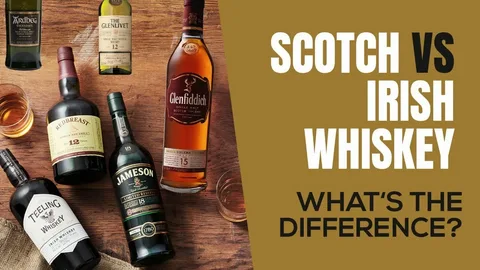Whiskey enthusiasts often debate the merits and distinctions of Bourbon and Scotch, two of the world’s most revered spirits. Each offers unique flavors, histories, and production methods that cater to diverse palates and preferences. This guide will explore the key differences between Bourbon and Scotch, delve into their production processes, and provide insight into choosing the right type for your taste.
Introduction to Bourbon and Scotch
What is Bourbon?
Bourbon is a type of American whiskey primarily made from corn. It has a rich and full-bodied flavor, often with notes of vanilla, oak, and caramel. By law, to qualify as Bourbon, the spirit must be produced in the United States, made from at least 51% corn, and aged in new, charred oak barrels. The spirit cannot be distilled to more than 160 proof and must be entered into the barrel for aging at no more than 125 proof. It must also be bottled at 80 proof or more.
What is Scotch Whisky?
Scotch whisky, often simply called Scotch, is made primarily from malted barley and water. It must be distilled and aged in Scotland. Scotch comes in several varieties including single malt, blended malt, single grain, and blended grain whisky. The aging process must take place in oak barrels for at least three years. Each type of Scotch has a distinct flavor profile ranging from light and smooth to rich and peaty.
Production Differences
Ingredients
Bourbon
Primarily made from corn, Bourbon must contain at least 51% corn in its mash bill. The remainder is usually a mix of barley, rye, or wheat.
Scotch
Scotch whisky primarily uses malted barley, although grain Scotch can include wheat or corn. The water used in Scotch production also significantly influences its taste, with many distilleries using water from local streams and rivers known for their unique mineral compositions.
Distillation Process
Bourbon
Bourbon is typically distilled using a column still. After distillation, the clear spirit is aged in new, charred oak barrels, which give Bourbon its distinctive color and flavor.
Scotch
Scotch can be distilled using either pot stills (for single malts) or column stills (for grain whisky). The choice of still affects the final flavor, with pot stills typically producing a richer, more complex spirit.
Aging
Bourbon
There is no minimum aging period for Bourbon, but to be considered straight Bourbon, it must be aged for at least two years. However, most premium Bourbons are aged for four years or more.
Scotch
Scotch must be aged in oak barrels for at least three years. However, many distilleries age their Scotch for much longer, with 12 years being a common minimum for premium brands.
Geographic Influence
Bourbon
While it can be made anywhere in the U.S., Kentucky is considered the heartland of Bourbon production due to its unique climate and limestone water, which is ideal for making whiskey.
Scotch
Scotch is deeply connected to Scotland, with the region’s cool, damp climate providing ideal conditions for slow aging of the whisky.
Flavor Profiles
Bourbon
Bourbon is known for its sweeter, fuller body compared to Scotch, with prominent notes of vanilla, oak, caramel, and a touch of smokiness due to the charred oak barrels.
Scotch
Scotch flavours vary widely depending on the style and region. Islay Scotches are known for their strong peaty, smoky character, while Speyside Scotches are often more mellow, with fruity and floral notes.
Choosing Between Bourbon and Scotch
Personal Taste
Preference for Bourbon or Scotch often comes down to personal taste. Those who prefer sweeter, more robust flavors might enjoy Bourbon, while those who appreciate a wider range of flavors and complexities may lean towards Scotch.
Occasion
Bourbon may be more suited to cocktails or drinking neat with a splash of water, while Scotch can be ideal for savoring slowly, especially older, more complex varieties.
Price
Both Bourbon and Scotch offer ranges from affordable to ultra-premium. Generally, older Scotches are more expensive due to the longer aging process and storage costs.
FAQs about Bourbon and Scotch
Can Bourbon be made outside the United States?
Legally, no. Bourbon is a distinctly American product and must be made in the United States to be labeled as Bourbon.
What does “single malt” mean in Scotch whisky?
Single malt Scotch whisky is made from only water and malted barley at a single distillery by batch distillation in pot stills.
Why is Scotch sometimes peaty?
Peat is used in the malting process of barley for some Scotch whiskies, particularly those from Islay. The smoke from the peat fire imparts a distinctive smoky flavor to the barley, which carries through to the final spirit.
How should I drink Bourbon or Scotch?
Both spirits can be enjoyed neat, with water, or on the rocks. Bourbon is also popular in cocktails like the Old Fashioned or Manhattan. The choice depends on personal preference and the quality of the whiskey.
What is the “angel’s share”?
The “angel’s share” refers to the portion of whisky that evaporates from the barrels during aging. This is higher in warmer climates, such as Kentucky, leading to faster aging of Bourbon compared to Scotch.
Are there any health benefits to drinking Bourbon or Scotch?
While moderate alcohol consumption can be part of a healthy lifestyle, whisky should be consumed in moderation. Both spirits contain antioxidants and have been shown to aid in digestion.
How long can I store Bourbon and Scotch after opening?
Both Bourbon and Scotch can last for years after opening if stored properly (upright, tightly sealed, out of direct sunlight). However, over time, exposure to air can alter the flavor.
Conclusion
Bourbon and Scotch are distinguished by their ingredients, production methods, and geographic origins, all of which contribute to their unique flavor profiles. Whether you prefer the sweet, rich tones of Bourbon or the diverse and often complex flavors of Scotch, each offers a distinctive tasting experience that reflects centuries of distilling tradition. By understanding these differences, enthusiasts can better appreciate each type of whiskey and choose the one that best suits their palate and preferences.
- 8 Signs and Symptoms of Vitamin A Deficiency - April 20, 2024
- Bourbon vs. Scotch Whiskey: What the Difference? - April 20, 2024
- What Is Metabolic Confusion and Does It Work? - April 20, 2024




